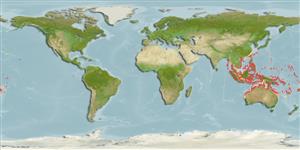Common names from other countries
Environment: milieu / climate zone / depth range / distribution range
Ecologie
Rifbewoner; diepteverspreiding 0 - 30 m (Ref. 348). Tropical; 23°C - 30°C (Ref. 102835); 29°N - 28°S, 91°E - 170°W
Indo-West Pacific.
Length at first maturity / Size / Gewicht / Leeftijd
Maturity: Lm ?, range 13 - 15 cm Max length : 50.0 cm SHL mannelijk/geslacht niet bekend; (Ref. 117184); common length : 20.0 cm SHL mannelijk/geslacht niet bekend; (Ref. 348)
The valves are thick, heavy and triangular in shape, often covered with reddish spots and obscured by encrustations. The mantle is a deep yellowgreen, irregularly mottled at the periphery and in the center.
Collected for food and shell, the latter commonly used in the shellcraft industry (Ref. 348). Maximum depth from Ref. 75831. In relatively shallow water, in lagoon, barrier and fringing reefs (Ref. 106851). Found in intertidal areas on corals (Ref. 75831). Tridacnids derive their nutrition from uptake of dissolved matter through their epidermis and from their symbiotic zooanthella Symbiodinium microadriaticum (Ref. 107098).
Life cycle and mating behavior
Geslachtsrijpheid | Voortplanting | Kuitschieten | Eieren | Fecundity | Larven
Broadcast spawners. Life cycle: Embryos develop into free-swimming trocophore larvae, succeeded by the bivalve veliger, resembling a miniature clam (Ref. 833).
Poutiers, J.M. 1998. (Ref. 348)
Status op de Rode Lijst van het IUCN (Ref. 130435)
Status bij CITES (Ref. 108899)
Not Evaluated
Gevaarlijk voor mensen
Harmless
Gebruik door de mens
Visserij: commercieel; Aquacultuur: commercieel
| FishSource | Sea Around Us
Tools
Internet-bronnen
Estimates based on models
Preferred temperature
(Ref.
115969): 25.6 - 29.3, mean 28.7 (based on 2485 cells).
Weerstandsvermogen
laag, minimale populatieverdubbelingstijd 4,5-14 jaar (K=0.12-0.2; tm=4).
Kwetsbaarheid
Moderate to high vulnerability (50 of 100).
Prijsklasse
Unknown.
